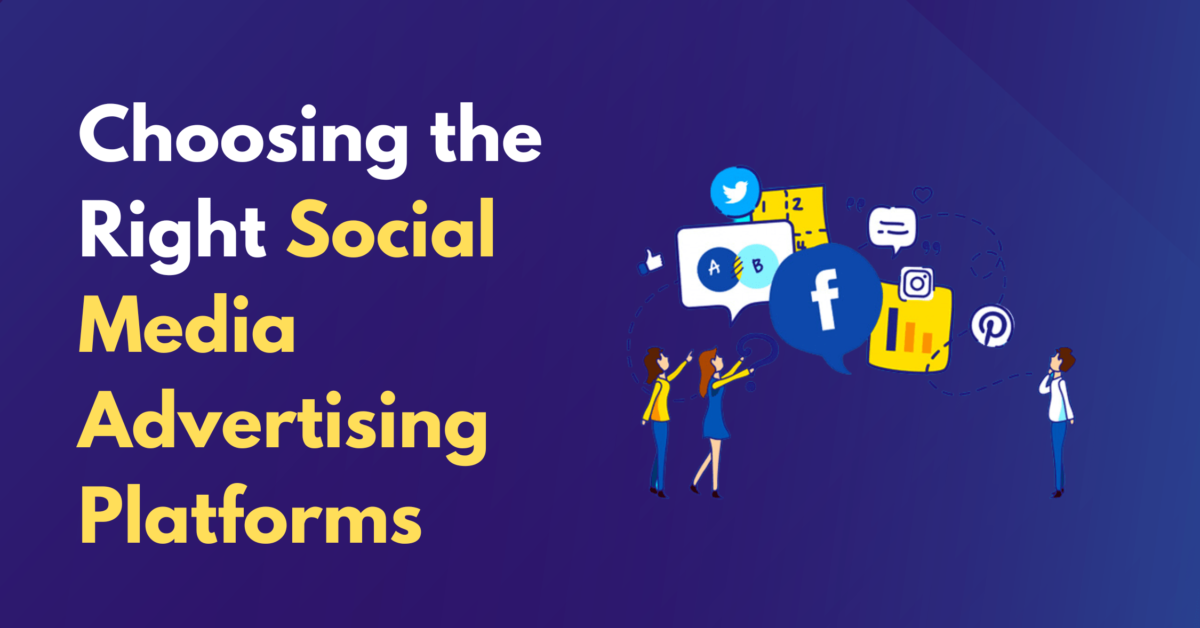Choosing the Right Social Media Advertising Network
Getting your material seen might be difficult in the midst of ongoing changes to search engine rankings and social media algorithms. Although organic search is the more convenient and cost-free alternative, there is little possibility of becoming viral without putting some money on the line.
Paid social advertising, which involves serving advertisements to social media users, has emerged as the surest way to drive traffic and make sales from day one.
According to a recent survey, 75% of Gen Zers and 48% of millennials are making purchasing decisions influenced by social media ads, and in 2020, social media ad spending in the US was valued at $40.3 billion.
Whether you are a big or small business owner, social media advertising is a must, especially if you want to stand out from the crowd, gain content views, and drive more sales.
How to Choose the Right Social Media Advertising Network for Your Business
Define Your Advertising Goals:
Start by setting clear, specific goals for your social media advertising. These could include increasing brand awareness, driving website traffic, generating leads, boosting sales, or even promoting a specific product or service. Your goals will serve as a compass for choosing the right platform and ad strategy.
Know Your Audience:
Understanding your target audience is fundamental. Create detailed buyer personas that include demographics, psychographics, interests, pain points, and online behavior. This information will help you align your choice of platform with your audience.
Research Platform Demographics:
Different social media advertising platforms attract different user demographics. Here’s a more detailed breakdown:
Facebook:
It has a broad user base, but it tends to skew slightly older. It’s great for reaching a wide range of audiences.
Instagram:
Predominantly used by a younger audience, especially those under 35. Visual content and aesthetics are vital here.
Twitter:
Known for real-time updates and a diverse user base. It’s effective for news and trending topics.
LinkedIn:
Highly professional and business-oriented, making it ideal for B2B marketing and networking.
Pinterest:
The female-dominated platform is often used for lifestyle, DIY, and design content.
TikTok:
Popular among Gen Z, focusing on short-form video content. It’s ideal for creative and trendy campaigns.
Analyze Advertising Options:
Each platform offers different ad formats, including:
- Image Ads: Static images with a compelling message.
- Video Ads: Engaging video content, short or long.
- Carousel Ads: In a swipeable format, numerous images or videos.
- Sponsored Posts: Promoting your organic content to a wider audience.
- Stories Ads: Short, vertical video or image ads in a story format.
Choose ad formats that align with your content and campaign objectives.
Budget and Cost:
Determine your advertising budget, and be realistic about what you can afford. Some platforms offer more cost-effective options for different goals. For example, Facebook and Instagram provide a wide range of budget options, making them accessible for small businesses.
Competitor Analysis:
Study your competitors’ social media presence. See which platforms they use for advertising and observe their strategies. This can give you insights into where your target audience is active and how to differentiate your campaigns.
Content Relevance:
Assess the type of content you plan to promote. If you’re in an industry where visual and lifestyle content is essential, platforms like Instagram and Pinterest may be more suitable. If your content is more professionally oriented, LinkedIn could be a better fit.
User Engagement:
Think about how involved users are with each platform. Platforms with high user engagement are more likely to yield better results. For instance, Instagram and Facebook often have high engagement rates due to the interactive nature of the content.
Tracking and Analytics:
Ensure that the platform you choose provides robust tracking and analytics tools. These insights are essential for measuring the success of your campaigns, optimizing them, and proving the return on investment (ROI) to stakeholders.
Test and Iterate:
Don’t limit yourself to one platform. It’s often beneficial to test your advertising efforts on multiple platforms simultaneously. Run small test campaigns and analyze the results. Allocate a larger portion of your budget to the platform that performs the best.
Compliance and Policies:
Be aware of each platform’s advertising policies and compliance guidelines. Violating these rules can result in your ads not being approved or, in extreme cases, your account being suspended. Ensure your ad content adheres to the platform’s rules.
Consider Multiple Platforms:
Depending on your resources and strategy, you can run campaigns on multiple platforms. This is known as a multi-channel approach. It allows you to target different audience segments or run various types of ads simultaneously. Just make sure you can effectively manage and analyze them.
Best Social Media Platforms to Advertise On
Consider the distinct audiences that each social media platform has when choosing where to place your ads. Find these audiences and reach out to them there.
The following list includes the top social media advertising platforms:
1) Facebook
It’s reasonable to assume that Facebook, the biggest social media site in the world, is a trustworthy option when choosing where to promote. There is a strong probability that your target audience is using Facebook as it is popular across a wide range of demographics.
Facebook users may interact and share material online, but the network also gives businesses the chance to promote their goods and services there. The following Facebook advertising choices can assist you in reaching your campaign objectives:
Image and Video ads
The most fundamental ad types Facebook offers are image and video ads, which are also among the easiest to create.
Stories ads
Through Facebook, Messenger, or Instagram, stories ads are full-screen image, video, or carousel advertisements.
Carousel ads
In a single ad, advertisers can display two or more images or videos thanks to carousel ads.
Slideshow ads
Slideshow ads are video-like advertisements that use up to ten images or one video and are presented as a slideshow.
Collections ads
People can find, browse, and buy products from their phones more easily thanks to collection ads.
Messenger ads
The Chats tab of the Messenger app features Messenger advertisements.
Playable ads
For mobile app advertisers to attract customers to their application by simulating a demo experience, playable ads are an interactive video ad format.
Also Read: Facebook Advertising: Reaching Your Target Audience
2) Instagram
Instagram, which is well-known for its glossy images and videos, is the perfect medium for businesses with visually attractive goods since it can be readily blended into visual media. With the second-highest interaction rate among social media platforms and one of the youngest audiences, Instagram also has a sizable user base.
Instagram ads, present ads like these:
Image and Video ads
The most frequent types of ads you will use and encounter are photo and video ads because Instagram advertising depends so heavily on images and videos.
Instant Experience ads
Ads using the Instant Experience (IX) format, formerly known as Canvas, are immersive full-screen advertisements primarily made for mobile devices.
Collection ads
Similar to Facebook, collection ads aim to assist users in discovering, browsing, and buying goods all from their mobile devices.
Explore feed ads
Instagram users can find new content, videos, and shopping opportunities on the Explore page, which is where the Explore feed ads are located.
Polling sticker ads
Polling ads are an interactive format used in Instagram stories to drive engagement and find what customers are looking for.
Instagram Shopping ads
Customers can tap a product tag in Instagram Shopping ads to get more details and learn how to buy a product.
3) Twitter
Since its debut in 2006, Twitter has been among the most well-liked social media platforms as the go-to source for finding breaking news and interacting with both unknown and well-known influencers.
Twitter advertising offers several different options for brands to create advertising, including:
Image and Video ads
Businesses can highlight their products and draw the attention of prospective customers using Twitter images and video ads.
Carousel ads
You can use carousel ads to tell a story while directing users to your website or app.
Moment ads
Users can create a collection of Tweets for Moments ads that allow them to go beyond the typical character limits to tell a compelling story.
Text ads
With likes, replies, favorites, and retweets, Twitter text ads resemble a typical tweet.
Follower ads
Follower advertisements advertise an account to a specific audience, increasing awareness and luring new followers.
Twitter Amplify ads
Pre-roll advertisements known as Twitter Amplify Ads are designed to match brands with the premium content that your customers are already watching, such as viral videos and highlights.
Twitter Takeover ads
As the first advertisement of the day on Twitter, takeover ads put your brand at the forefront of the discussion.
4) Pinterest
Another very visual platform is Pinterest, which features humorous wedding photos, cooking tutorials, and fashion reels. It is an ideal social media advertising platform considering its users typically use the platform to find and purchase products.
Brands can advertise on Pinterest using the following methods thanks to the site’s highly targeted search engine:
Standard and Video PIN ads
The main advertising choices for brands are Standard and Video Pin ads, which enable them to present top-notch content that will stand out in people’s feeds.
Carousel Pin ads
A Carousel Pin ad consists of more images than a Standard Pin.
Idea Pin ads
Idea Pin advertisements are a multi-page spread that shares ideas, highlights the brand’s personality, and directs customers to your store by using original content.
5) LinkedIn
Since it is the largest professional network in the world, LinkedIn can target clients based on their job credentials and has a large professional user base. The nature of LinkedIn advertising also makes it better suited to include B2B advertising campaigns, in contrast to most other platforms that concentrate on B2C advertising.
Also Read: 5 ways to boost your post reach on LinkedIn
There are several types of LinkedIn ads, including
Single-image and Video ads
Brands can captivate a professional audience with native image or video content at every stage of the buyer’s journey with the help of single image and video ads, which are displayed throughout the standard LinkedIn feed.
Carousel ads
With the help of a swipeable collection of cards, images, or videos in the LinkedIn feed, carousel ads let businesses tell an interactive story.
Event ads
Businesses can use Event Ads to promote LinkedIn events or webinars and increase attendance.
Document ads
By sharing documents within the LinkedIn feed, document ads enable brands and companies to increase customer engagement and lead generation.
Conversation ads
In order to drive professional conversations and promote goods or services, Conversation Ads work by involving prospects in LinkedIn Messaging.
Message ads
Using message ads, businesses can send direct messages to potential customers to elicit an immediate response and start a dialogue.
Lead Gen Form ads
Brands can quickly and easily gather quality leads from LinkedIn ads using Lead Generation Forms’ pre-filled forms or documents.
Text ads
Through elements like compelling headlines, succinct descriptions, or optional images, text ads can attract new clients to your company.
Spotlight ads
To drive more customers to your website, landing page, or store, spotlight ads highlight a brand’s goods, services, or activities.
Follower ads
Utilizing current connections to advertise your LinkedIn page and gain more followers is called “follower advertising.”
Social media advertising is one of the most efficient and successful methods to contact your target audience and turn them into customers. No other advertising solutions can generate the type of constant, scalable leads as social advertising.
You must learn the ins and outs of this advertising platform as more and more merchants start dipping their toes into social media, and you must begin bolstering your plan. With these suggestions under your belt and specific objectives to direct you, you’ll be well ahead of the game. With Metaloop Marketing, you can put your business in front of the appropriate audience on the appropriate channel at the appropriate moment.



Write a Comment